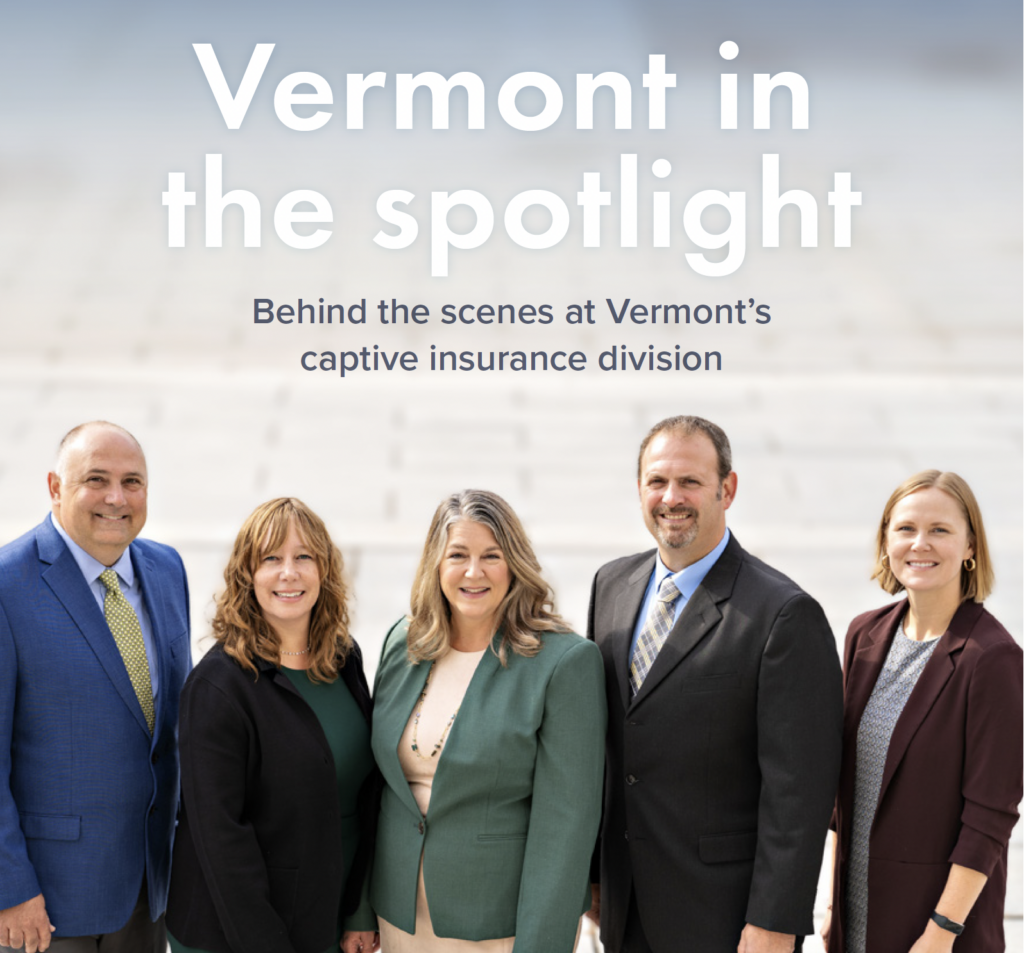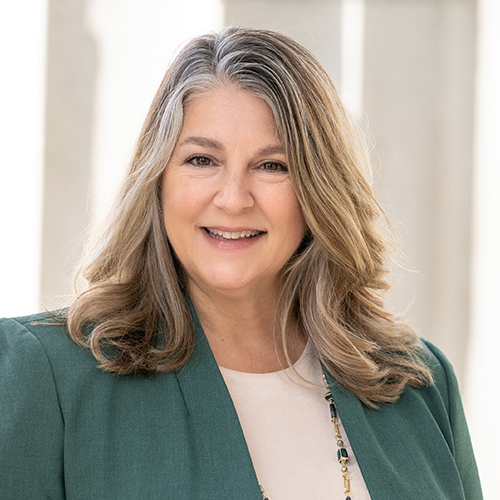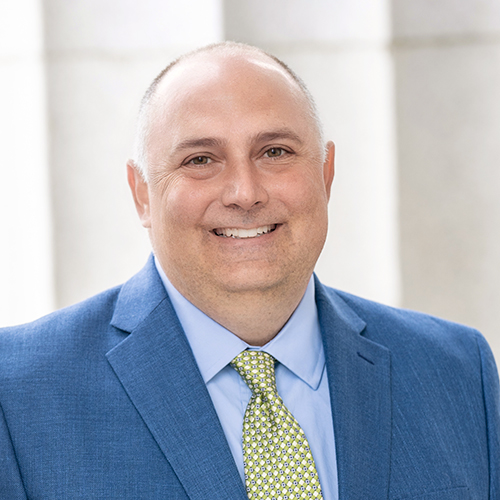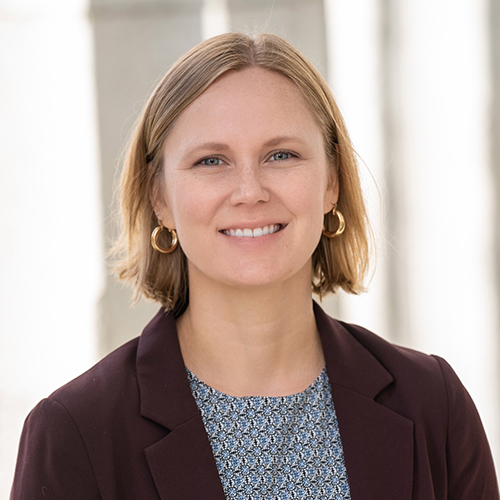
How long have you been with the Vermont Department of Financial Regulation (DFR)’s captive insurance division and what is your current role as deputy commissioner?

Sandy Bigglestone: I have been with the division for 26 years. My current role, as deputy commissioner, involves overseeing a staff of approximately 30 people. Together, we licence and regulate captive insurance companies and risk retention groups (RRGs) domiciled in Vermont. I represent Vermont at the National Association of Insurance Commissioners to stay abreast of varying requirements and changes, including any impact on captive insurance regulation, and to recommend best practices with respect to RRGs. I also represent Vermont at various industry events, including education and next generation initiatives. Reporting to the commissioner of the DFR, my role may involve broader administrative activities on behalf of the department or State of Vermont.
Can you explain your responsibilities in the administration and regulation of captive insurance companies?
My responsibilities include legislative initiatives and testimony. I am also in charge of the captive insurance division’s annual budget. I am involved in discussions with division staff on administrative, technical, or process improvement projects, and discussions with the industry on regulatory issues, business plan changes and prospective company applicants. I perform the final review of company applications for licensing, approve company plan of operations changes, and review final examination reports.
What led you to pursue a career in captive insurance regulation, and what aspects of your experience have been most valuable in your current role?
Before joining the division as an examiner, I was in public accounting. One of the firm’s partners had audit clients that were Vermont-domiciled captive insurance companies. I had audit engagements involving public entity risk pools and governmental entity risk pools and therefore I had familiarity with group risk sharing and insurance operations. When an examiner position opened up, I was encouraged to apply and talk to Len Crouse, who was the division’s leader at the time. My background as a certified public accountant, with auditing experience, was beneficial to adding value at the entry level, and in each of the positions I grew into at the division. Aside from my professional and technical background and development, I attribute a great deal of value in my current role to the knowledge and experience I gained from each of the various positions I occupied in the division, along with what I learned from my interactions with colleagues, other regulators and the many industry experts I have come to admire.
As a CPA and CFE, how do your qualifications contribute to your work in overseeing captive insurance companies?
The efforts involved in obtaining the designations prepared me for the technical qualifications of the work involved in understanding insurance operations. I maintain the designations by engaging in professional education every year, keeping up to date with the insurance, accounting, financial examination and analysis requirements. Access to technical resources and training through various professional organisations has allowed me to be prepared for any challenge we might be faced with — or at least feel confident in researching issues that may come up. What goals or initiatives do you have for the captive insurance division under your leadership as deputy commissioner? Continue to support the Vermont economy in a responsible way by upholding the mission of the division and employing the best standards for captive insurance regulation. I want to enhance Vermont’s position as a global leader for captive insurance and support a robust marketplace by continuing to grow, while attracting talent to the various job opportunities in the industry. I want our division to continue to provide the type of regulatory environment, responsiveness and friendly customer service our industry values. Internally, I want to maintain a healthy work culture for my staff, to ensure they know how valuable they are and how important the work they do is to the success of our domicile, building upon its character and reputation. As a leader, I want to be the reason staff feel welcomed, seen, heard, valued and supported. In turn, I want Vermont to be the reason companies also feel this way. ■
What is your role as director of captive insurance and how long have you been with the division?

Christine Brown: I started my career with the captive insurance division in 2003 as an insurance examiner and spent 13 years on the examination team in various roles, participating in all aspects of statutory exams and analysis. In 2016, I was promoted from an assistant chief examiner to the assistant director of captive insurance, where my focus shifted to captive licensing, legislative initiatives and industry outreach. In 2022, I was promoted to director of captive insurance to directly support deputy commissioner Sandy Bigglestone in the supervision of our more than 650 active licensed captives. In my role as director, I oversee new captive licensing, assist in the review of requests for business plan changes, help develop changes to laws, regulations, bulletins and guidance, supervise the analysis of non-RRG captive insurance companies, and participate in educational sessions and industry outreach. I am lucky to work with an expert team of approximately 30 captive insurance professionals, who work diligently to maintain high standards in licensing and solvency monitoring.
Could you elaborate on the responsibilities involved in managing Vermont’s captive regulatory operations?
Upholding Vermont’s regulation comes with great responsibility. Our team is responsible for licensing quality captives that meet our stringent regulatory requirements and expectations; monitoring compliance with relevant laws, regulations and guidelines; conducting risk assessments and performing analysis for financial solvency. This robust regulatory framework ensures that captive owners are better prepared to weather adverse market conditions and inevitable setbacks that sometimes come with owning and operating an insurance company. In addition, we are involved in rule-making and policy development to ensure effective regulation in a rapidly changing market. We frequently participate in industry outreach and education to raise awareness about captive insurance and regulatory requirements. We take pride that we have gained the trust and confidence of domestic and international businesses and captive insurance regulators from many other jurisdictions. An essential key to our regulatory approach is to stay responsive to captive owners and the changing market dynamics while upholding our commitment to the highest of standards.
How has your background in public accounting, particularly in the captive insurance field, influenced your work in the division?
I was lucky enough to get my start in the captive industry as an auditor with Johnson Lambert, learning from some of the industry’s brightest people like John Prescott and Magali Welch. This experience gave me a strong foundation and deep understanding of the operations and financial statements of captive insurance companies. Regulators and auditors think alike and have very similar objectives. Today, I rely on our approved auditors to provide independent and objective opinions on the financial statements of captives domiciled in our state. Their work empowers me and my team to make informed decisions and helps us maintain the stability of our regulatory system.
What are the key factors or indicators you consider when monitoring the financial condition of captive insurers domiciled in Vermont?
No two captive insurance companies are the same, so we find that taking a balanced and deliberate approach works best. When looking at solvency ratios and financial results, we consider each captive’s unique approved business plan, its retained risk, fronting and reinsurance partners, sources of funding, and the financial strength of its parent or owner(s) and their ability or intent to support the captive.
Can you highlight any notable achievements or developments during your tenure as director of captive insurance?
When I first moved from the examination team to support the director and deputy commissioner in 2016, I used my knowledge in risk focused exams and analysis to enhance our licensing process to provide information to our examination team that assists in focusing our resources in areas we consider to be higher risk at the time of licensing. This approach and working together as a team promotes effectiveness and efficiency in regulation. ■
“No two captive insurance companies are the same, so we find that taking a balanced and deliberate approach works best”
What is your role as assistant director of captive insurance and how long have you been a part of the captive division?

Jim DeVoe-Talluto: I was hired as a captive examiner and analyst in 2004. Later that year, I was promoted to examiner-in-charge (EIC), a position I held through 2008, at which time I left the division and embarked on a one-year sabbatical in Central America with my family. I was re-hired in late 2009 and continued in my role as EIC until September 2022, when I accepted the assistant director position. In total, I have been with the captive division for more than 18 years.
Could you provide insights into the specific tasks and responsibilities you handle in supporting Vermont’s captive regulatory operations?
As assistant director of captive insurance, I provide direct support to Christine Brown, director of captive insurance, and Sandy Bigglestone, deputy commissioner. One of my primary responsibilities is conducting reviews of captive applications that we receive throughout the year. In these reviews, we assess the strength of the parent or sponsor, analyse the captive projections and other financial information included with the application, as well as evaluate corporate governance and prospective insurance policies and other agreements. I also participate in introductory meetings with prospective captive applicants and their Vermont business partners. In these meetings, we discuss the proposed business plan, initial capitalisation and key partners in the programme. Other responsibilities include support and oversight of the annual analysis process for pure captives and participation in industry conferences along with our partners at VCIA and the Vermont Department of Economic Development.
How does your prior experience in public accounting and captive management contribute to your work in the captive division?
In public accounting, I worked in the audit and tax space for mid-sized businesses, so while these companies were not captive-specific, I gained perspective on both auditing standards and corporate tax issues. As a captive manager, I developed a deeper understanding of the captive accounting and reporting requirements, and I was on the other side of the examination process in support of our captive clients.
What are the key challenges or considerations involved in monitoring the financial condition of captive insurers?
For pure captives, the captive is often only as strong as its parent company, so we look closely at the financial condition of the parent as well as the leadership and governance that occurs at the parent level. A strong culture of risk management is also critical. Specific to the captive entity, we look to key solvency ratios, such as premiums to surplus or reserves to surplus, to determine the health of the entity. At formation, statutory minimum capital levels are typically a starting point and additional capital is often warranted based on the risks and limits written.
From your perspective, what advantages does Vermont offer as a domicile for captive insurance companies and how does the captive division contribute to maintaining that reputation?
The captive division has an unrivalled depth of experience among its staff. A majority of our staff members have similar backgrounds and experience, with 10 or more years of regulatory experience, combined with previous tenures in captive audit or management. We rely on this depth of knowledge to inform future decisions and support innovation in the captive industry. When we take a prospective applicant’s call, there is frequently more than 60 years of combined regulatory experience that will inform our decision-making. ■
“At formation, statutory minimum capital levels are typically a starting point and additional capital is often warranted based on the risks and limits written”
Can you describe your role as the director of captive examinations and the main responsibilities of your team in the captive division?

Dan Petterson: As the director of captive examinations, my role is to oversee the monitoring function of our Vermont captive industry, with an ultimate goal of ensuring the solvency and health of our captive insurers and their respective stakeholders. Solvency monitoring essentially encompasses two primary components, examinations and analyses, and operates in a cyclical nature whereby ongoing analyses roll into exams and back into analyses. Operationally, my role entails strategising, organising and directing our team of 25 examiners and analysts in the ongoing completion of up to 125 captive exams per year, annual analyses of 85 risk retention groups, and various analyses on our more than 500 other captives.
How does your background in public accounting and experience in regulating traditional insurance companies contribute to your work in overseeing Vermont captive insurance companies?
My background in auditing captive insurers and experience in regulating traditional insurance companies is initially what led to the opportunity to regulate captive insurers. That experience was invaluable in preparing me for the role I am currently in, but things are rapidly changing. Our jobs require us to be knowledgeable about laws and regulations, financial examinations, financial analysis, auditing, accounting, risk management, actuarial standards, traditional insurance, and captive insurance as well as others. My background provided a great foundation, but there is something new to learn every day. All of this keeps the jobs interesting and it keeps us on our toes.
What are some of the key factors or criteria your team considers when examining and ensuring the responsible operation of Vermont captive insurance companies?
Our monitoring procedures are all risk-focused. We put an emphasis on those areas of the companies that we assess as providing for the greatest risk to solvency. These risks could be numerous for a captive, or they could be few. Much of our assessment will depend on the size, sophistication and complexity of the companies we are reviewing. For most captives, we look to see if the parent or sponsor is healthy. A large parent with a small captive programme may pose little risk in the larger picture, but if that parent is having financial difficulties, it could have an impact on the captive. It is nice to know that a parent or sponsor has resources if a captive gets into trouble, but if there are fewer resources at that level, we must ensure that the captive has the ability to weather some variability. We also always look to see if capital is sufficient for the business being written. It is important to note that sufficient capital is typically not the same as — and is generally more than — our statutory minimum capital requirements. We look to see that pricing and reserving are adequate, that governance and controls are effective, and that the company is in compliance with its business plan and Vermont laws and regulations. It is important to note that we look at the risks that could impact a captive’s ability to continue to operate in a healthy and solvent manner moving forward. We are interested in where a captive has been and how they look today, but we are also where theyare going and whether they have the ability to get there.
How do you stay updated on the latest rules, regulations and industry best practices to effectively carry out your role in the captive division?
Communication is key! We are fortunate to be part of such a large and diverse team that is constantly communicating and learning from one another. To some degree, we stay updated because of our willingness to share what we are all hearing and learning daily as part of our job. We talk to captive managers, attorneys, accountants, actuaries and other service providers. We have discussions with management, directors and other key captive contacts where possible. Our team is active in conferences from a presenting and training aspect, as well as a networking aspect, and at various industry training sessions. We are active on NAIC working groups and disseminate information that we receive as part of that relationship. We have a very active advocacy group, the VCIA, which also provides training and a great deal of information to our team. We are readers, listeners, and often contributors to all the various publications and broadcasts covering our industry and disciplines. We also monitor and interact on social media. There is so much information to stay current on and so many resources that it can be quite overwhelming for one or even a few individuals to keep track of. Collectively, however, we are able to funnel the important stuff into our processes and into the hands of those that need to know and the decision makers.
What strategies or initiatives has your team implemented to promote compliance and maintain the integrity of the captive insurance market in Vermont?
Many of the more recent initiatives revolve around being as efficient and effective as possible in all that we do. We strive to provide a value-added environment by interacting with our companies, by allocating resources to areas that pose greater risks, and by being consistent in our regulatory efforts. We have also fostered a very collaborative working relationship with various captive service providers that typically serves as our first line of defence in monitoring our companies. The tone throughout industry is very upbeat and the message is clear — we want to be the regulator of choice when it comes to captives, we want to be the first place you look to or call when you have a question, and we want to continue to deliver as well as or better than we ever have. ■
As captive insurance economic development director, what are your primary responsibilities in promoting Vermont’s captive insurance industry?

Brittany Nevins: My primary responsibility is to market Vermont globally as a captive insurance domicile and to engage with businesses that may be interested in forming a captive insurance company and are considering Vermont as a domicile. How this looks in practice is managing our website, social media, content creation, and the coordination of our various sponsorships, article opportunities and events we participate in. A significant part of my role is ensuring that Vermont is represented authentically and that our information is clear and accessible.
How do you collaborate with the DFR and Vermont Captive Insurance Association (VCIA) to enhance the state’s reputation as a premier captive insurance domicile?
While I am in the Vermont Department of Economic Development in the agency of commerce and community development, and I am intentionally separate from the regulatory aspects of the captive insurance programme, I work very closely with my colleagues at the DFR captive insurance division. I also work closely with the VCIA in the facilitation of educational information and collaborating around various association events and activities. For me to do my job well, I need to be able to lean on our regulators and their expertise to provide thought leadership and give input into the various marketing initiatives I am undertaking. Their input is extremely valuable to my work — it allows me to fairly represent the work of the division and the expert regulation they provide. We have a regular standing meeting with the division and the president of the VCIA, where we can brainstorm and collaborate on the projects I am working on and where they can also provide ideas for future projects. Finally, I attend various conferences throughout the year and work closely with my colleagues at the DFR and VCIA to speak with businesses and on panels.
Could you elaborate on your role in advising Vermont’s governor and secretary of commerce on captive insurance legislation and policy recommendations?
I send a weekly report to the secretary of the agency of commerce and community development and the governor’s office that includes updates on the captive insurance programme, such as articles published, points of collaboration, and any information I feel is important for the leadership to be aware of. During the legislative session, I will include updates in the legislative process and will request a meeting with the leadership when necessary. The legislative process is very smooth as the captive bill is drafted every year with input from the VCIA and proposals are carefully vetted — so typically, I do not need to engage with leadership beyond regularly updating them. They are very supportive of the captive insurance industry in Vermont and want to see its continued success.
What specific strategies or initiatives have you implemented to attract the expansion and relocation of businesses within Vermont’s captive insurance industry?
I focus much of my time on maintaining Vermont’s strong reputation as the “gold standard” of captive insurance regulation in the world. Vermont has a particular brand of accessibility to regulators, efficiency and quality regulation. Because this is authentically who we are and we have decades of work supporting this reputation, I really focus much of my energy on storytelling and thought leadership. Those who are interested in forming a captive, and professionals in the industry, want to hear from our expert regulatory team and service providers in Vermont and I spend quite a bit of my time facilitating this sharing of knowledge and “putting a face” to this robust industry. This also has the added benefit of raising awareness about captive insurance as a potential career path in Vermont, which is an area of focus we have identified. I also work with the VCIA in the consideration of future road shows and international trade missions where we can raise awareness about captive insurance as a possible tool for companies and organisations. Lastly, conferences and events are important for us as we meet quite a few businesses that are interested in forming a captive insurance company. I work to ensure that we have appealing resources and information available at our conference booth for companies at these various events. I love coordinating the purchase of locally made maple syrup to have at our booth and supporting local businesses in our conference giveaways.
How do you engage with Vermont’s congressional delegation to monitor policy related to captive insurance regulation and financial services industries?
In my time in this role, I’ve had to engage with the congressional delegation very little. There is tremendous support for the captive insurance industry at all levels of government and it is rare for a concern to rise to the level of the congressional delegation’s attention. Occasionally, they will have questions they send my way that I will field to the appropriate regulator and schedule a meeting when necessary. The industry in Vermont is tremendously stable, so there is little need to engage with the congressional delegation — which is a good thing! Whenever we have needed to engage, they have been eager to learn and support in any way they can, recognising the tremendous benefits to the Vermont economy. ■


